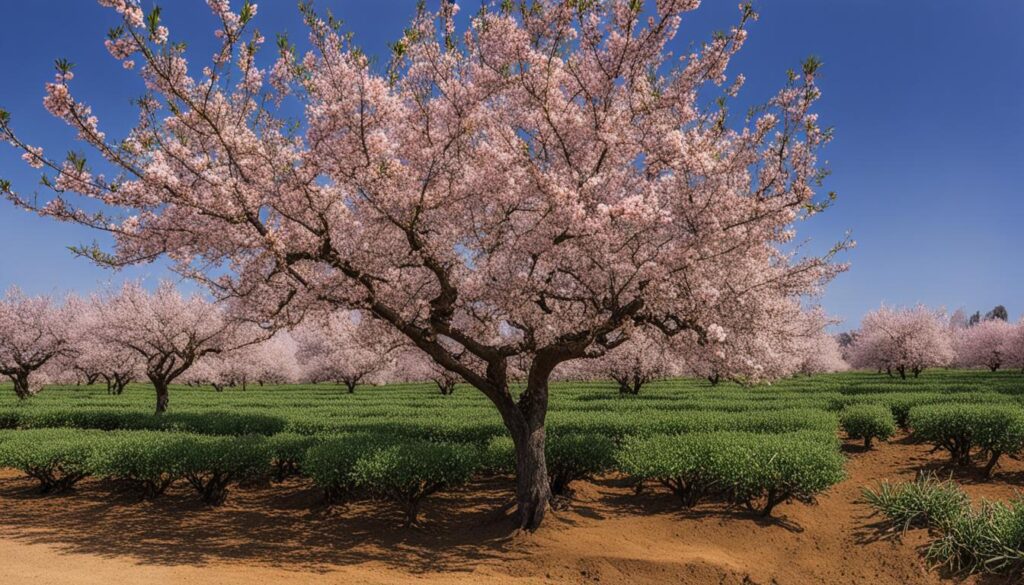Are you interested in growing your own delicious almonds? Almond trees can be a great addition to your garden or backyard orchard. Not only do they produce tasty nuts, but they also offer beautiful blossoms that attract beneficial insects like bees. In this article, we will explore the ideal growing zone for almond trees, climate requirements, and cultivation best practices to ensure your almond trees thrive.
When it comes to growing almond trees, understanding the ideal growing zone is crucial. Almond trees thrive in Mediterranean-like climates, with warm, dry summers and mild winters. They are best suited for USDA hardiness zones 7 to 9, where temperatures range from 0°F (-17°C) to 100°F (38°C).
For successful cultivation, make sure to choose a sunny spot in your garden with well-draining soil. Almond trees prefer sandy or loamy soil that is slightly acidic with a pH level between 6 and 7. Proper soil preparation, including adding organic matter and ensuring adequate drainage, will create the ideal growing conditions for your almond trees.
Watering is another essential aspect of almond tree care. Young almond trees require regular watering during their first year to establish a strong root system. Once established, almond trees are drought-tolerant and can survive with minimal watering. However, providing regular deep watering during the growing season will promote healthy nut production.
Pruning is also crucial for almond trees. Proper pruning helps maintain the tree’s shape, remove dead or diseased branches, and promote airflow, reducing the risk of pests and diseases. It’s best to prune almond trees during late winter or early spring before new growth begins.
By following these cultivation best practices and considering the almond tree’s ideal growing zone, you can enjoy a fruitful harvest of your own almonds. So, roll up your sleeves, prepare your garden, and get ready to embark on a rewarding almond-growing journey.
Cultivation and Growing Conditions for Almond Trees
If you’re planning to cultivate almond trees, understanding their specific growing conditions is crucial for their successful development. Almond trees have been cultivated for thousands of years, with their origins traced back to 4,000 BC in central and southwestern Asia. Although their exact ancestry remains unknown, almonds have played significant roles in various religious and cultural practices throughout history, including biblical mentions and their association with festivities like weddings, where sugared almonds are traditionally given as gifts.
To ensure optimal growth and yield, it’s vital to consider the climate requirements, suitable soil conditions, and watering needs of almond trees. They thrive in areas with a Mediterranean climate, characterized by mild, wet winters and hot, dry summers.
When it comes to soil, almond trees prefer well-drained soil with a pH range of 6 to 7.5. Sandy loam or loamy soil is ideal, as it promotes root development and prevents excess moisture that could lead to diseases. Before planting, amend the soil with organic matter to improve its fertility, drainage, and nutrient content.
Watering is a critical aspect of almond tree care. During the first two years after planting, young trees require regular and consistent watering to establish deep root systems. However, once established, almond trees are relatively drought-tolerant and can withstand dry periods. It’s important to strike a balance between providing enough water to sustain the trees and avoiding overwatering, which can lead to root rot and other diseases. Regularly monitor soil moisture levels and adjust watering accordingly.
By providing the right growing conditions, you can ensure healthy and thriving almond trees. In the next section, we will explore different almond tree varieties, their pollination requirements, and essential care practices to maximize their productivity.
Varieties, Pollination, and Care for Almond Trees
When it comes to cultivating almond trees, choosing the right variety is crucial for success. There are several almond tree varieties that thrive in different climates and conditions. Popular options include ‘Carmel,’ ‘Mission,’ ‘All-In-One,’ ‘Hall’s Hardy,’ ‘Nonpareil,’ and ‘Penta.’ By selecting the appropriate variety, you can ensure optimal growth and fruit production.
Pollination is another critical aspect of almond tree cultivation. While some varieties are self-pollinating, others require cross-pollination with another compatible variety. ‘All-In-One’ is a recommended choice for backyard orchards, as it is a smaller-sized tree and capable of self-pollination. However, if you choose a variety that requires cross-pollination, make sure to plant compatible trees nearby.
Proper planting and care are essential for the health and productivity of your almond trees. Start by selecting a planting location with well-drained soil and ample sunlight. Almond trees prefer sandy or loamy soil with a pH range of 6.0 to 7.5. Regular watering, especially during dry spells, is crucial, as almond trees have moderate water needs. Additionally, pruning your almond trees in late winter or early spring helps maintain their shape, remove diseased or dead wood, and promote better airflow.
Pest and disease management is vital to protect your almond trees from common threats. Regular monitoring for pests such as aphids, mites, and borers is essential, as is implementing appropriate control measures if an infestation occurs. Common almond tree diseases include almond scab, powdery mildew, and brown rot, which can be managed through proper sanitation, cultural practices, and, if necessary, targeted treatments.
What are the Best Growing Zones for Almond Trees?
When looking for peach tree growth stages information, it’s important to consider the best growing zones for almond trees. Almond trees thrive in growing zones 7-9, where they can enjoy the warm, dry climate and well-drained soil that they need to produce a bountiful harvest.










